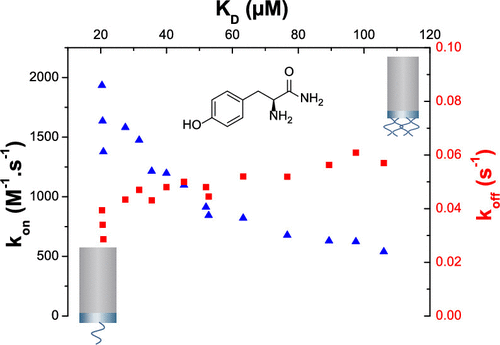Our official English website, www.x-mol.net, welcomes your
feedback! (Note: you will need to create a separate account there.)
Direct Detection of Low-Molecular-Weight Compounds in 2D and 3D Aptasensors by Biolayer Interferometry.
ACS Sensors ( IF 8.2 ) Pub Date : 2020-08-05 , DOI: 10.1021/acssensors.0c00925 Anthony Vignon 1 , Arthur Flaget 1 , Maxime Michelas 1 , Mehdi Djeghdir 1 , Eric Defrancq 1 , Liliane Coche-Guerente 1 , Nicolas Spinelli 1 , Angéline Van der Heyden 1 , Jérôme Dejeu 1
ACS Sensors ( IF 8.2 ) Pub Date : 2020-08-05 , DOI: 10.1021/acssensors.0c00925 Anthony Vignon 1 , Arthur Flaget 1 , Maxime Michelas 1 , Mehdi Djeghdir 1 , Eric Defrancq 1 , Liliane Coche-Guerente 1 , Nicolas Spinelli 1 , Angéline Van der Heyden 1 , Jérôme Dejeu 1
Affiliation

|
The direct biolayer interferometry (BLI) measurement of low-molecular-weight (LMW) analytes (<200 Da) still represents a challenge, in particular, when low receptor densities are used. BLI is a powerful optical technique for the label-free, real-time characterization and quantification of biomolecular interactions at interfaces. We demonstrate herein that the quantification of biomolecular recognition is possible by BLI using either 2D-like or 3D platforms for aptamer ligand immobilization. The influence of the aptamer density on the interaction was evaluated and compared for the two sensor architectures. Despite the LMW of the analyte, BLI monitoring led to signals that are exploitable for affinity and kinetic studies, even at low aptamer density. We demonstrate that the immobilization format as well as the aptamer density has a crucial influence on the determination of the recognition parameters.
中文翻译:

通过生物层干涉仪直接检测2D和3D Aptasensors中的低分子量化合物。
低分子量(LMW)分析物(<200 Da)的直接生物层干涉法(BLI)测量仍然构成挑战,特别是在使用低受体密度的情况下。BLI是一种强大的光学技术,可用于对界面处的生物分子相互作用进行无标记的实时表征和定量。我们在本文中证明通过使用2D样或3D平台进行适体配体固定化,通过BLI可以定量生物分子识别。对于两种传感器架构,评估并比较了适体密度对相互作用的影响。尽管分析物的分子量较低,但即使在低适体密度下,BLI监测仍可产生可用于亲和力和动力学研究的信号。
更新日期:2020-08-28
中文翻译:

通过生物层干涉仪直接检测2D和3D Aptasensors中的低分子量化合物。
低分子量(LMW)分析物(<200 Da)的直接生物层干涉法(BLI)测量仍然构成挑战,特别是在使用低受体密度的情况下。BLI是一种强大的光学技术,可用于对界面处的生物分子相互作用进行无标记的实时表征和定量。我们在本文中证明通过使用2D样或3D平台进行适体配体固定化,通过BLI可以定量生物分子识别。对于两种传感器架构,评估并比较了适体密度对相互作用的影响。尽管分析物的分子量较低,但即使在低适体密度下,BLI监测仍可产生可用于亲和力和动力学研究的信号。











































 京公网安备 11010802027423号
京公网安备 11010802027423号